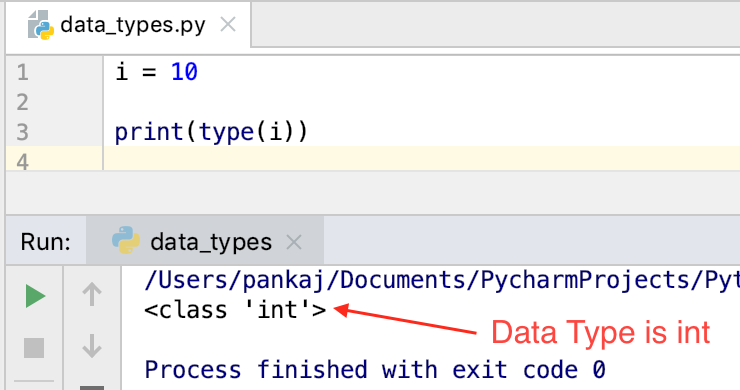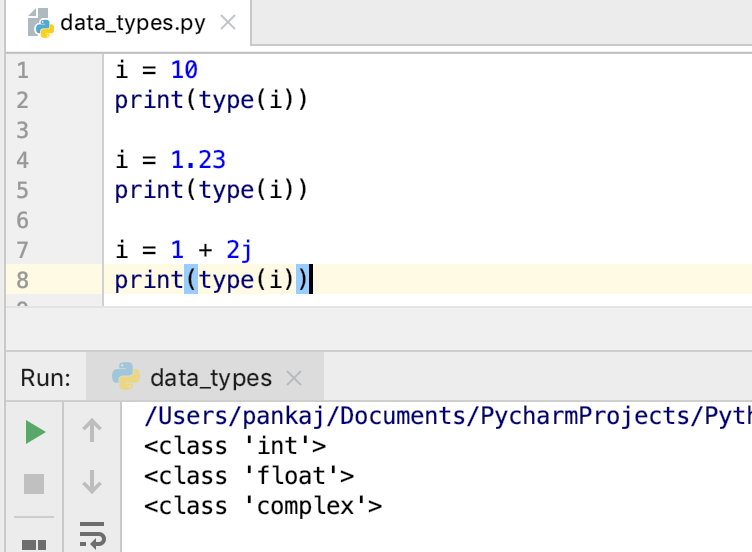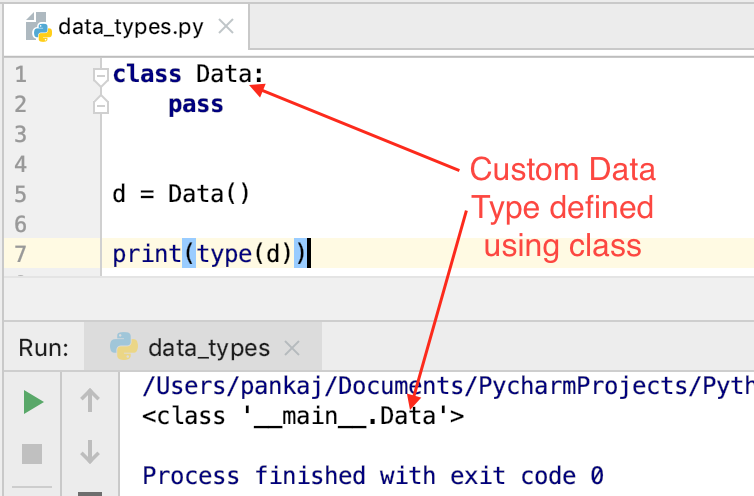Python is an object-oriented programming language. Every variable in Python is an instance of some class. There are many pre-defined Python data types. We can create our own classes to define custom data types in Python.
What are the Popular Data Types in Python?
Some of the popular data types in Python are:
- Numbers – int, float, complex
- Sequences – String, List, Tuple, Set
- Map – Dict
Python Data Types Check
We can use type() function to check the data type of a variable.
i = 10
print(type(i))

Let’s look at some examples of data types in Python.
Python String Data Type
Python strings are the instances of class ‘str‘. The string is a sequence of Unicode characters. Python strings are immutable. We can define a string using single quotes (‘) or double quotes(“).
The string is the most popular data type in Python. There are various operations supported for string objects – length, format, split, join, slicing, etc.
s = "abc"
print(type(s))
s1 = 'hello'
print(type(s1))
print(s[1:2])
print(len(s))
print(s.split('b'))
Output:
<class 'str'>
<class 'str'>
b
3
['a', 'c']
Python Numbers Data Types
There are three data types in the numbers category – int, float, and complex. There was another data type ‘long’ in Python 2 but it got deprecated in Python 3.
i = 10
print(type(i))
i = 1.23
print(type(i))
i = 1 + 2j
print(type(i))

Python Tuple Data Type
A tuple in Python is an ordered sequence of items. The tuple is immutable i.e. once defined we can’t change its values.
We can define a tuple using parentheses where items are separated using a comma. A tuple can contain any number of elements and the elements can be of any type.
t = (1, 2, 3)
print(type(t))
t = ('a', 1, [1, 2])
print(type(t))
Output:
<class 'tuple'>
<class 'tuple'>
Python List Data Type
The list is almost the same as Tuple, except that it’s mutable. The order of the elements is maintained.
Python List is defined using brackets and the elements are separated using commas.
my_list = [1, 2, 3]
print(type(my_list))
my_list = ['a', 1, [1, 2]]
print(type(my_list))
Output:
<class 'list'>
<class 'list'>
Python Set Data Type
Python Set is an unordered collection of items. Set can’t have duplicate values. The order of elements is not maintained in the Set.
A set is defined using braces where the elements are separated using commas. Python Set uses hashing to store elements. So the elements must be hashable i.e. hash() function should work on them. Since List is unhashable, we can’t store a List object in the Set.
my_set = {1, 2, 3, 1}
print(type(my_set))
print(my_set)
my_set = {'a', 1, 'a'}
print(type(my_set))
print(my_set)
Output:
<class 'set'>
{1, 2, 3}
<class 'set'>
{1, 'a'}
Let’s see what happens when we try to have a List as the Set element.
>>> my_set = {1, [1]}
Traceback (most recent call last):
File "<stdin>", line 1, in <module>
TypeError: unhashable type: 'list'
>>>
Python Dictionary Data Type
Python Dictionary is an unordered collection of key-value pairs. It’s defined using braces and the elements are separated using commas. The key and value can be of any type. The key-value pair is defined using a colon (key: value).
Python Dictionary objects are of type ‘dict’. They are good to store a large number of values where fast retrieving is required.
my_dict = {"1": "Apple", "2": "Banana"}
print(type(my_dict))
my_dict = {1: 1, 2: 'b', 3: [1, 2]}
print(type(my_dict))
Python dictionary uses hashing on the key to store and retrieve elements, so the key object must support the hash() function. That’s why we can’t use a list as the key of a dictionary element.
>>> my_dict = {[1]: "a"}
Traceback (most recent call last):
File "<stdin>", line 1, in <module>
TypeError: unhashable type: 'list'
>>>
Defining Custom Data Type in Python
We can define a custom data type by creating a class in Python.
class Data:
pass
d = Data()
print(type(d))

Does Python Functions have a Data Type?
So far we have seen that the data type is associated with Python variables. But, do python functions also have a data type?
Let’s check this with a simple program.
def foo():
pass
print(type(foo))
Output:
<class 'function'>
So Python functions also have a data type – function. They are the instances of class function.
Does Python Class Methods have a Data Type?
Let’s see if the python class methods also have a data type or not.
class Data:
def foo(self):
pass
d = Data()
print(type(d.foo))
Output:
<class 'method'>
So Python class methods have the data type as ‘method’. They are the instances of class ‘method’.
Summary
Python is an object-oriented programming language. Everything in Python is an object of some class, even the functions and class methods. We can use the built-in type() function to determine the data type of an entity in Python.